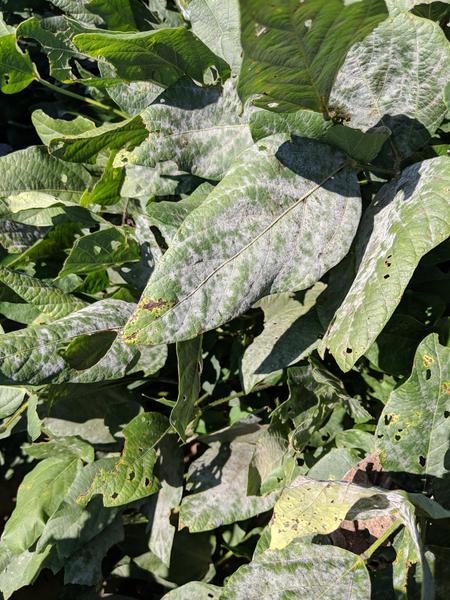Powdery Mildew
- Scientific Name(s)
- Microsphaera diffusa
- Type
- Disease
- Leaf Condition
- White Mold, Tip Burn, Webbing On Leaves, Leaf Spot
- Leaf Color
- Black Irregular Spots, Patchy Yellow And Brown Areas
- Leaf Location
- Entire, Upper, Lower, Young, Mature
- Petioles Condition
- Lesion
- Field Distribution
- Random, Low Areas, Localized Area
- Prior Environmental
- Rain, Cool Cloudy
- Season
- Early Vegetative, Mid To Late Vegetative, Flowering, Pods Present
- Cropping System
- Soybean Followed By Soybean, Conventional Till, Reduced Till
Introduction
Powdery mildew is a common leaf disease of ornamentals and crops caused by an obligate biotrophic fungus, meaning the fungus can only grow on a living host. This disease is favored by cool conditions, which happens rarely in North Carolina during the growing season.
Pathogen
Powdery mildew of soybean is caused by the fungus Erysiphe diffusa (syn. Microsphaera diffusa). Other common hosts of this fungus include common bean, pea, mung bean, and cowpea. The pathogen is an obligate biotroph, which means the fungus needs a living host to grow on. The pathogen disperses via spores, and the spores can travel long distances in wind currents.
Symptoms
Symptoms include a white, powdery coating on infected leaves. White to gray powdery patches begin small, but patches coalesce to cover the entire leaf as the disease progresses. Severity of symptoms may vary amongst cultivars. Some varieties exhibit leaf yellowing, scorching, or rust-colored patch symptoms. In severe infestations, plants may defoliate prematurely. Necrotic tissues may mimic symptoms of herbicide injuries. Pods may become heavily infected and reduce pod fill resulting in shriveled, underdeveloped seed.
Disease Cycle
Conidia (asexual spores) are released from lesions and spread to healthy plant tissues, where they are capable of causing new infections. Rainfall is not required for disease to occur. Overwintering structures of powdery mildew (chasmothecia) are formed when two mating types are present and merge. The role of overwintering structures and sexual spores (ascospores) has not been described in the soybean powdery mildew system, and may not likely impact epidemics.
Disease Management
Chemical management, while effective at reducing disease, is not recommended as the disease does not typically affect soybean yields. Crop rotation is not an effective tool for managing soybean powdery mildew since the spores can travel long distances. Varieties vary in their susceptibility to powdery mildew, but most commercially available varieties have some level of resistance.
Useful Resources
- The Crop Protection Network Factsheet provides diagnostic and control information for powdery mildew in soybean
- The NC State University Plant Disease and Insect Clinic provides diagnostics and control recommendations
- The NC State Extension Plant Pathology portal provides information on crop disease management
- The North Carolina Agricultural Chemicals Manual provides pesticide information for common diseases of North Carolina. The manual recommendations do not replace those described on the pesticide label, and the label must be followed.
Acknowledgements
This factsheet was prepared by the NC State University Field Crops and Tobacco Pathology Lab in 2020.
- Check out our Facebook and our Twitter!



